Sunday 27 September 2015
Discover the Power of Mudra – Hand Gestures in Buddhist Art
Sotheby's exhibition on 16 September, Images of Enlightenment: Devotional Works of Art and Paintings, traces the development of Buddhist art across Asia. This short video describes the importance of hand gestures, or 'mudra' in Sanskrit, which were used to convey specific meanings to the viewer.
Photo Report of "Kublai Setsen Khan - 800" exhibition
In scope with the 800th birth anniversary of Kublai Setsen Khan, the exhibition titled "Kublai Setsen Khan - 800" is being showed at the National Museum of Mongolia until October 20th. The exhibition consists of 300 archaeological discoveries, scriptural findings and heritage findings of the Yuan Dynasty found on Mongolian territory.
Working hours of Mongolian National Museum: Daily 08AM - 08.30PM
Address: West side of the Government House, Juulchin Street, Chingeltei District
Inquiry: (+976 - 11) 326802, (+976?) 70110911
Address: West side of the Government House, Juulchin Street, Chingeltei District
Inquiry: (+976 - 11) 326802, (+976?) 70110911






 Vessels from Khubilai's invasions of Japan /found from Japanese sea/
Vessels from Khubilai's invasions of Japan /found from Japanese sea/ Drawing showing Mongolians' attack in 1293 /restored at Saitama's museum in 1819-1843/
Drawing showing Mongolians' attack in 1293 /restored at Saitama's museum in 1819-1843/
 Язгууртны дээл
Язгууртны дээл

























 Юань улсын судар /Юань Ши/ XX зуун
Юань улсын судар /Юань Ши/ XX зуун
Saturday 26 September 2015
Through Asia in the Sven Hedin track
Lars Larsson "Through Asia in the Sven Hedin track"
September 29, 2015
Kalmar Slott
Kalmar Sweden
Guided tour of our seasonal exhibition, National Geographic, with subsequent lecture upptäktsresande Lars Larsson.
Sven Hedin (1865-1952) is Sweden's foremost adventurer and explorer of all time. Around the turn of the century, he explored the last white spots on the world map in the interior of Asia. In the spring of 2013 journalist and adventurer Lars Larsson began a ten-year project in the form of a series of expeditions to Asia in the track of Sven Hedin, which is funded by National Geographic. The aim of the project is to compare how the landscape and culture of the places Hedin visited has changed over the past century. The first trip took him to the Middle East's highest mountains and through the eastern Iranian deserts. In the summer of 2015, he undertook a second expedition to the mountainous Pamir Mountains in Central Asia to climb the mountain Muztagh Ata and study the Kyrgyz nomadic culture that Sven Hedin had close contacts with in 1894. The trip included the countries of Kyrgyzstan, Tajikistan, Afghanistan and China. The main objective of the expeditions is to locate Sven Hedin's historic camera positions and take new photographs from the exact same places so as to visualize the changes that have occurred over the past century. In the lecture given at Kalmar Castle Larsson tells the exciting story of Sven Hedin's life as an explorer and his own adventures and encounters with the cultures that Sven Hedin explored. It will be a trip up the snow-covered mountain peaks, performing wild rivers and through burning deserts.
29th of September at. 19.30. A guided tour at. 18:30 of the castle's seasonal exhibition National Geografic included in the price.
Tickets and soup
Take the opportunity to enjoy a soup in the castle restaurant before the lecture. The soup is served from noon. 16:00.
Ticket 150kr
Ticket including soup & wine 295kr
Ticket including soup & alcohol free 260kr
Friday 25 September 2015
Blown Away: The (Attempted) Mongol Invasion of Japan
Japan had expected the Mongol invasion for years.
In 1266, Kublai Khan, the new Mongol emperor of China, sent envoys to Japan with a letter addressed to the “King of Japan”–a title guaranteed to offend the Japanese emperor. The letter itself was equally unpalatable. The Great Khan “invited” Japan to send envoys to the Mongol court in order to establish friendly relations between the two states–code for the tributary relationship China habitually imposed on its neighbors. The letter ended with an implicit threat: “Nobody would wish to resort to arms.” Both the largely symbolic imperial court at Kyoto and the military government at Kamakura, which had controlled Japan since the late twelfth century, chose to ignore the khan’s overtures.
For several years Kublai Khan was distracted by more immediate concerns: subduing the newly conquered province of Korea and his war against the Song dynasty of southern China. It was 1274 before the Mongol emperor turned his attention to Japan once more. On November 2, a fleet of 900 ships sailed from Korea with over 40,000 men, including Chinese, Jurchen, and Korean soldiers and a corps of 5,000 Mongolian horsemen. The invasion forces landed first at the islands of Tsushima and Iki, where the local samurai were overwhelmed by the sheer numbers of their attackers.
With the intervening islands secured, the Mongols moved on to the Japanese mainland, landing at Hakata Bay on November 19. The Japanese were waiting for them, alerted by the news from Tsushima and Iki. When the Mongols landed, the twelve-year-old grandson of the Japanese commander-in-chief fired the shot that was the traditional opening in a samurai battle: a signaling arrow with a perforated wooden head that whistled as it flew to draw the attention of the gods to the deeds of bravery about to be performed. The Mongols responded with raucous laughter.
It was an omen of how the day’s battle would proceed. Both armies depended on their archers, but their fighting styles were dramatically different. The Japanese were accustomed to fighting in small-group or individual combat, seeking out worthy opponents by shouting a verbal challenge. They fired single arrows aimed at specific targets. The Mongols advanced in tightly knit formations and fired their arrows in huge volleys. Their movements were accompanied by roaring drums and gongs, which frightened the Japanese horses and made them difficult to control. When the Mongol forces pulled back, they fired paper bombs and iron balls that exploded at the samurais’ feet–something the Japanese had not seen before.
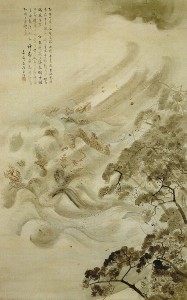 Seriously outnumbered and baffled by the invaders’ tactics, the Japanese were not able to hold the beaches. By nightfall, they had retreated several miles inland. Instead of pressing forward, the Mongolian forces returned to their ships for the night. A successful attack the next day seemed inevitable, but that evening an unseasonable storm struck the Mongol fleet, dashing its ships against the rocks. With their ships smashed and about one-third of their force dead, the Mongols withdrew. The Japanese hailed the storm as a divine wind (kamikaze), sent by the gods to protect them.
Seriously outnumbered and baffled by the invaders’ tactics, the Japanese were not able to hold the beaches. By nightfall, they had retreated several miles inland. Instead of pressing forward, the Mongolian forces returned to their ships for the night. A successful attack the next day seemed inevitable, but that evening an unseasonable storm struck the Mongol fleet, dashing its ships against the rocks. With their ships smashed and about one-third of their force dead, the Mongols withdrew. The Japanese hailed the storm as a divine wind (kamikaze), sent by the gods to protect them.
Seven years later, Kublai Khan tried again. The Mongols launched a two-pronged attack against Japan, with a combined fleet of almost 4,000 ships and 140,000 men. The Eastern Army sailed from Korea on May 22; the Southern Army sailed from southern China on July 5. The two fleets were to meet at Iki and proceed together against mainland Japan. The Eastern Army subdued Tsushima and Iki in early June. Instead of waiting for the Southern Army to arrive, they moved on to Hakata Bay.
Japan had used the intervening years to build earth and stone fortifications along the coast of Hakata Bay. When the Mongols arrived, Japanese defenders repulsed the attack from a secure position behind the defensive walls. When the Mongols retreated, the Japanese took the war to them, using small boats to attack the Mongosl at night. After a week of fierce fighting, the Eastern Army retreated to Iki Island to await the arrival of the Southern Army.
The two Mongol forces rendezvoused in early August. On the evening of August 12, the Japanese attacked, using the “little ships” tactic that had been successful before. The Mongols responded by linking their ships together to create a defensive platform. The battle continued through the night. At dawn, the exhausted Japanese retreated, expecting a decisive attack and the subsequent invasion of the mainland. Instead the Mongol ships, still linked together, were caught in a typhoon that dashed the ships against each other and the shore. When the typhoon subsided, the surviving ships headed out to sea, leaving thousands of stranded soldiers behind them to be massacred by the Japanese.
Japanese chroniclers cited the winds as proof that the gods themselves protected the island. The idea of “divine winds” (kamikaze) that protected Japan against invasion remained an important element in Japanese political mythology as late as the Second World War.
Thursday 24 September 2015
Set of 9 volumes “Khubilai Khan the Wise and His Inheritors” published in Mongolia
From: English.News.Mn September 21, 2015
The Mongolian Government has decreed that the 800th anniversary celebration of Khubilai Khan the Wise should be a nationwide event. As part of the celebration, the specialists at the History and Archeological Institute of the Academy of Sciences have published a set of nine volume entitled “Khubilai Khan the Wise and His Inheritors”, which includes the biography of Khubilai, as well as research on the social, economic and cultural situation not to mention the scientific achievements of the Yuan Dynastu, and the historical contribution to world history. The work was officially launched at the “Internom Book Store” yesterday.
Ibn Battuta's Travels, new exhibition in the Hermitage
In the State Hermitage Museum in St. Petersburg from 9 September till 15 December 2015 a brand new exhibition
"A Gift to Contemplators". Ibn Battutta's Travels
On 8 September 2015 on the top floor of the Winter Palace the exhibition “A Gift to Contemplators” Ibn Battuta Travels opened along with the display of the Culture and Art of Iran in the 8th to Early 20th Centuries.
The book of Ibn Battuta’s travels, entitled A Gift to Contemplators of the Wonders of Cities and the Marvels of Travelling, is a sort of synthesis of the personal experiences of an outstanding traveller and the popular conceptions of his contemporaries, whom he wished to please, a many-layered, fantastical collection of information about “wonders and marvels” in the manner of the 14th century.
Abu Abdallah Muhammad ibn Muhammad ibn Abdallah al-Lawati at-Tanji, known as Ibn Battuta, was born in the Moroccan city of Tanja (Tangiers) in AD 1304. Members of his family traditionally performed the duties of qadis or judges and the boy received a classical Muslim education that included study of the Koran, the hadiths (sayings of the Prophet Muhammad), legal literature and the basics of calligraphy.
At the age of 21, the Moroccan decided to make a pilgrimage to Mecca (the hajj). He set off on the second day of the month of Rajab in the year of the Hegira 725 (13 June 1325), passing eastwards through the countries of the Maghreb and making a stop in Egypt, visiting not only Cairo and Alexandria, but also Upper Egypt. Then he set off for Syria and later went on to Mecca with a Syrian caravan.
Although the pilgrim had already performed his first hajj, his wanderlust compelled him to spend almost 30 years travelling, in the course of which he visited Iran, Iraq, Yemen, the east coast of Africa and also the interior of the continent, Asia Minor, the Crimea, the Golden Horde, Constantinople, Central Asia, India, China, the Maldive Islands and Spain. Those were, in rough outline, the milestones on the journeys of that great Maghrebi.
In 1354 he returned to Morocco, where on the orders of the Sultan of Fez, Abu Inan Faris, his memoirs were written down by Ibn Juzayy, a scholar from Granada.
In his opus the author devotes great attention not only to holy places, ascetics and scholars, but also to the main political figures of the era, such as the Egyptian Sultan al-Malik al-Nasir Muhammad ibn Qalawun (1285–1341), Khan Uzbek of the Golden Horde (c. 1283–1341) and the Indian ruler Muhammad Shah (1325–1351) of the Tughlaq dynasty. The traveller met many of them personally, while he gives information about others drawn from a variety of sources. There are numerous descriptions of objects from daily life, such as food, fabrics, utensils, means of transport and money. Besides that, Ibn Battuta readily divulges information about his own personal life. It emerges from his book that during his years of journeying he married repeatedly, acquired concubines and even a whole harem, on the Maldives, for example.
The exhibition, featuring around 300 items, the majority of which are being displayed for the first time, presents the world of Ibn Battuta’s day, follows his route and demonstrates the various spheres of life that the traveller encountered. This is, furthermore, a splendid opportunity to bring together works of art from places as far apart as Spain and China, the Volga basin and central Africa, to show their variety and interconnectedness in the Late Middle Ages.
Among the exhibits from the Hermitage are ceramics, fabrics, metal objects, glassware, architectural details and numismatic items. Many have inscriptions containing the names of historical personages mentioned by Ibn Battuta, who came into contact with the celebrities of his age.
The second participant in the exhibition, the National Library of Russia, has provided more than 30 unique manuscripts, Islamic (Arabic and Persian), Christian and Judaic. These exhibits make it possible to show the intellectual life and range of reading matter available in the traveller’s time and also to demonstrate the art of the book in that era through the example of masterpieces, many of which are being exhibited for the first time.
The Moscow-based Mardjani Foundation, the third participant in the exhibition, presented, along with pieces of metalwork and ceramics, unique costumes of the late 12th to early 14th centuries. These items, which have survived practically intact, illustrate the everyday world and also recreate the appearance of the elite of the era.
An illustrated scholarly catalogue has been prepared for the exhibition (State Hermitage Publishing House, 2015). The curators of the exhibition are Anton Dmitriyevich Pritula, head of the Byzantium and Middle East sector of the State Hermitage’s Department of the East, Candidate of Philological Sciences, and Anastasia Nikolayevna Tepliakova, junior researcher and acting Chief Curator of the State Hermitage’s Department of the East.
To get an impression of the (beautiful but alas, written in Russian) catalogue, please click HERE
Was this 1,300-year-old mountain palace built for a tragic Chinese princess?
Jaw-dropping pictures of Siberian ruins as new royal theory may explain this remote 7th century summer schloss.
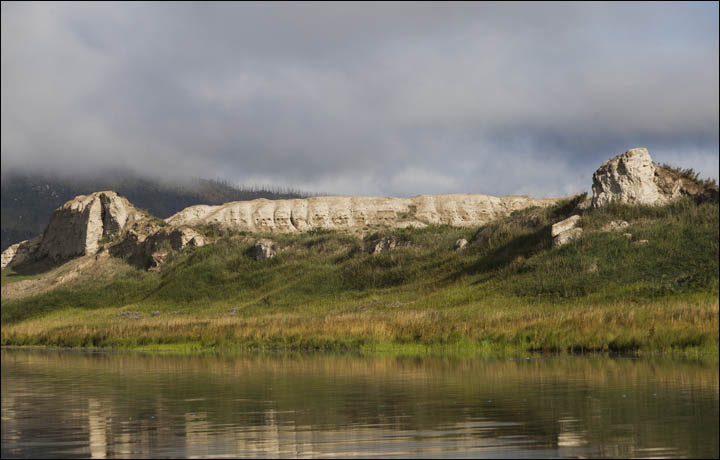
When it was constructed, Por-Bajin was nowhere near the hub of any civilisation, nor on a known ancient trade route. Picture: Vera Salnitskaya
It is among the most mysterious palazzos anywhere, and although it is located at 'the very centre of Eurasia' - presumably by chance not design - it must be one of the most inaccessible.
Rapid erosion of its breathtaking but vanishing grandeur may, before too long, deprive archeologists of the opportunity to prove why this place, known as Por-Bajin, was built, and who by. Or should the question should be: who for?
Erected on an island in Lake Tere-Khol by - probably - 757 AD , the palace, close to the present-day Russian border with Mongolia, has long fascinated yet frustrated experts in equal measure, but now we may be edging closer to answering the questions that have for so long perplexed scientists.
When it was constructed, Por-Bajin was nowhere near the hub of any civilisation, nor on a known ancient trade route. One fact seems abundantly clear, and deepens the riddle of this lavish mountain retreat: no-one ever lived here.
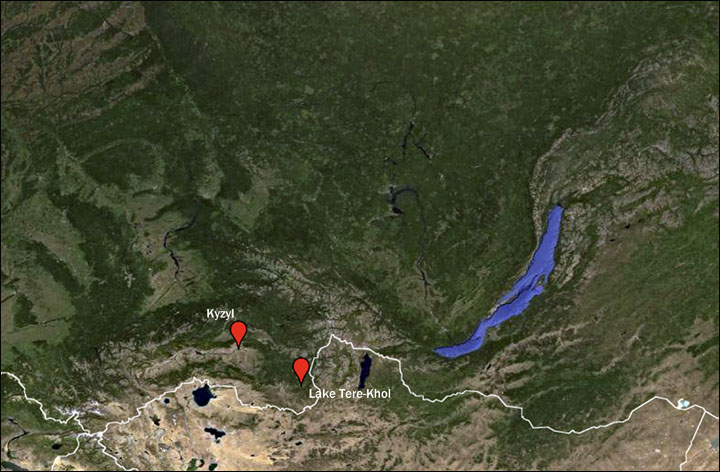
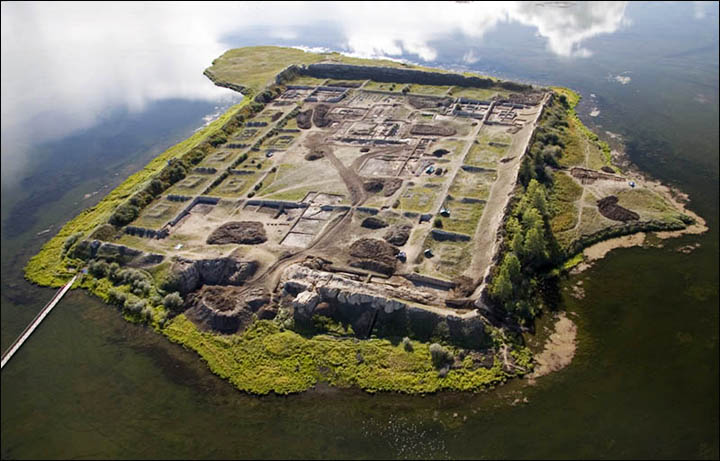

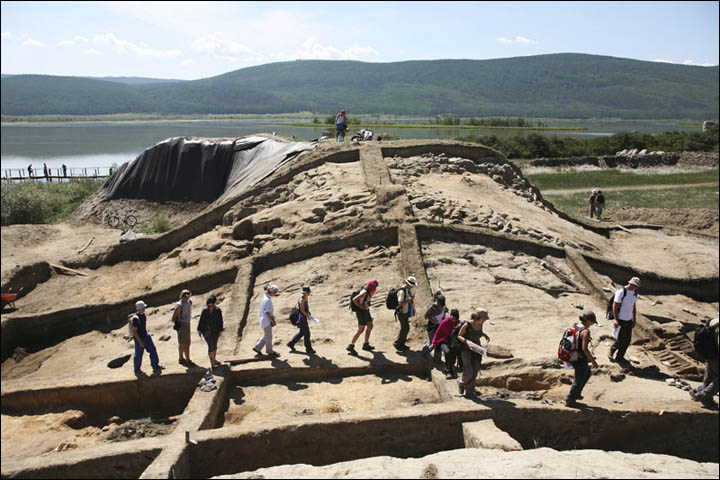
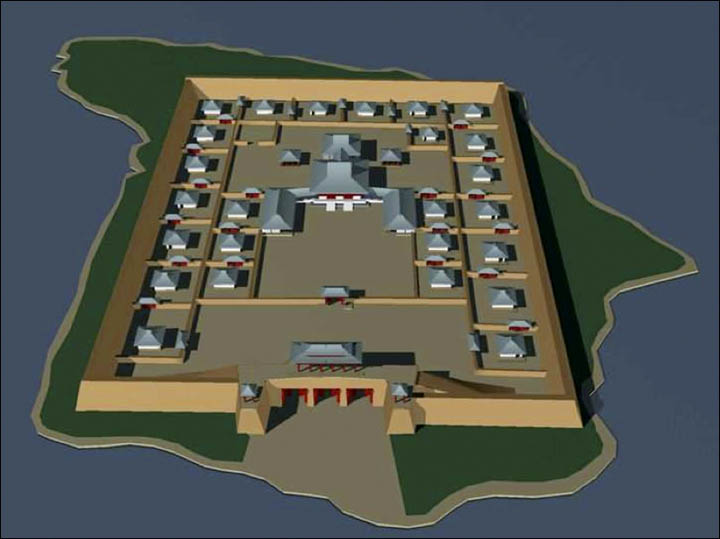
Erected on an island in Lake Tere-Khol by - probably - 757 AD , the palace, close to the present-day Russian border with Mongolia, has long fascinated yet frustrated experts. Pictures: gdehorosho.ru, 'Por-Bajin Fortress' foundation, Irina Arzhantseva
Another is that it was designed solely for summer living. Some 2,300 metres above sea level in the mountains between the Sayan and Altai ranges, archeologists say no allowance was made for the bone-chilling cold of winter.
Yet it had been scrupulously built to the demanding edicts of its ancient designers: for example, the towering outer walls were ten metres tall and 12 metres wide. They were planned to be impenetrable.
It has been described as 'a kremlin-like fortress' with its centrepiece a structure the inner courtyard supported by no less than three dozen wooden columns resting on stone bases.
Archaeologists found clay tablets of human feet, faded coloured drawings on the plaster of the walls, giant gates and fragments of burnt wood in what has been hailed as 'one of the most mysterious archaeological monuments of Russia'. Laser mapping helped experts build a 3D model of what the palace - on a 3.5 hectare site - might have looked like in its heyday.
Russian ethnographer Dmitry Klements, who examined the ruins in 1891, believed it to be an Uighur fortress, a view echoed by Soviet archaeologist Sevyan Vainshtein, who conducted the excavations on the site in the decade following 1953. Another theory, later discounted, was that this was a Budhist monastery. One more idea was that it was an astronomical observatory.
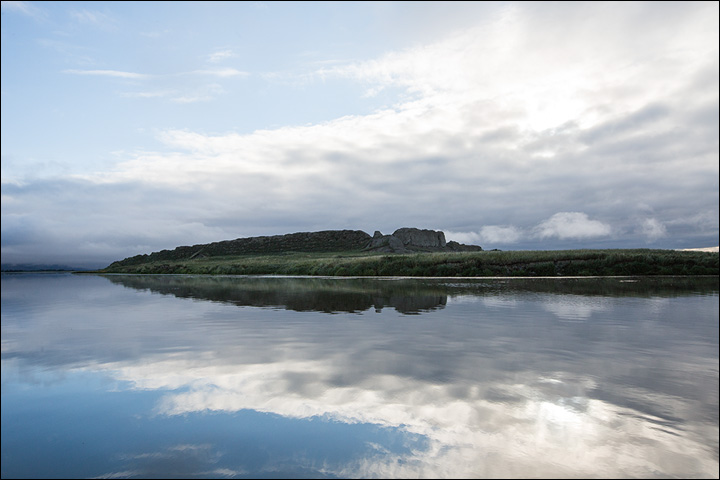
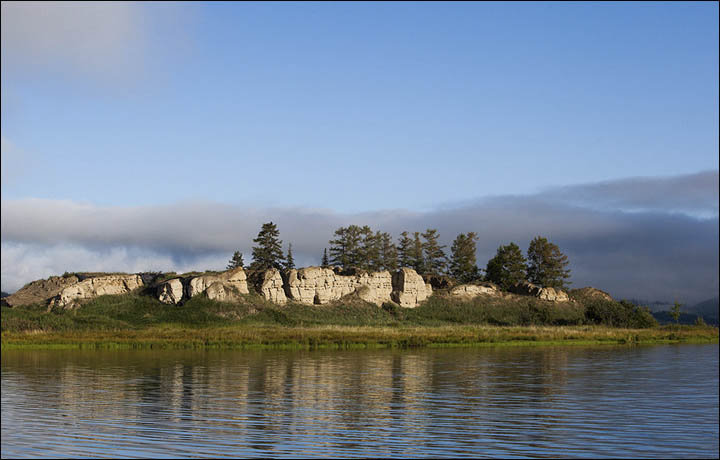
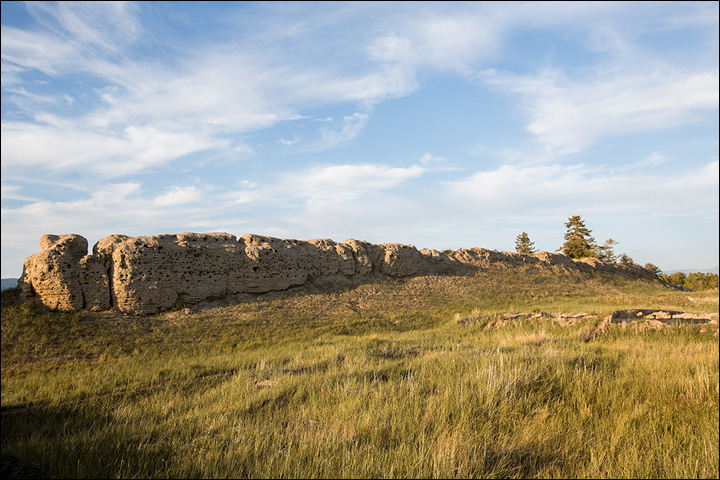
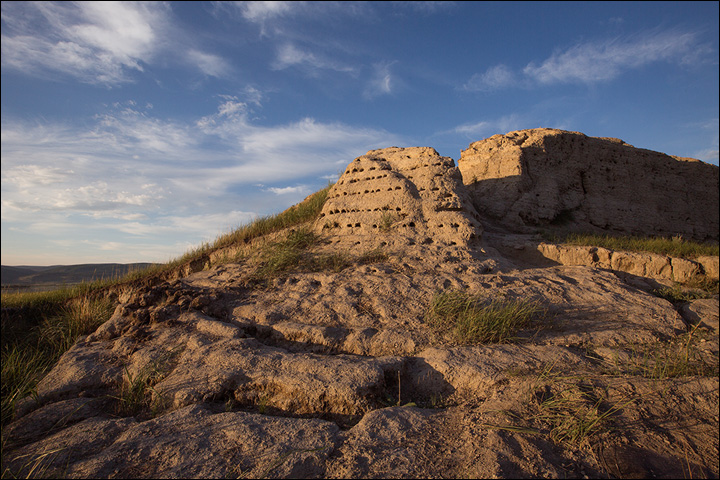
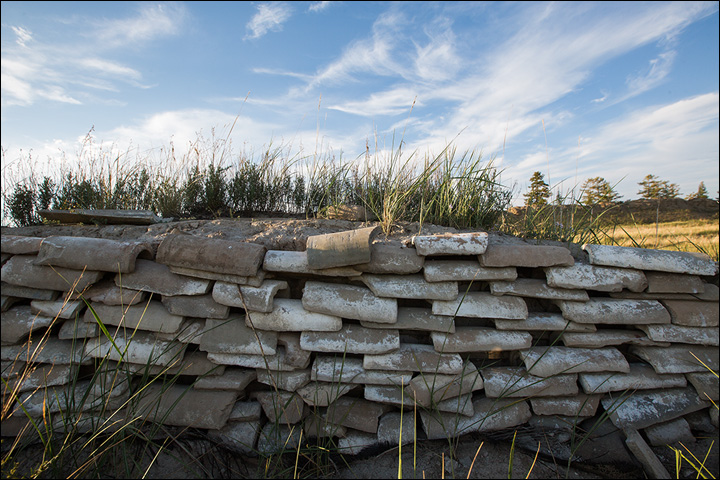
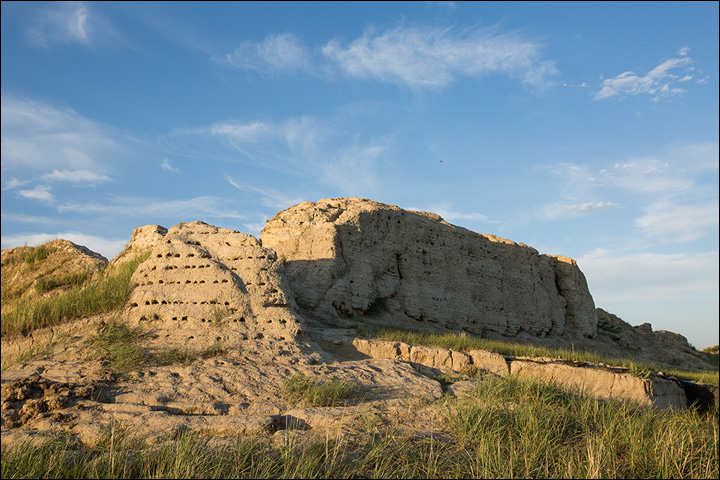
The towering outer walls were ten metres tall and 12 metres wide. They were planned to be impenetrable. Pictures: Vera Salnitskaya
Vainshtein believed that ancient Uighur inscriptions found close to the Selenga River - which flows into Lake Baikal - are clues about this place. They refer to 'whitish camp and palace with a throne' yet there was no mention of the lake, which might have been artificial, according to some authorities.
Experts believed it could be the the summer palace of Uighur ruler - or Kha Khan - Boyan-Chor. Yet research involving archeological excavations begun in 2007-08 on the initiative of the Russian Defence Minister Sergei Shoigu - a native of Tuva, also known as Tyva - now questions this version.
The scientists established that there was almost no 'cultural layer' on this site. Hardly any evidence of man's presence here was found. Hence the conclusion that the VIP for whom it was built never lived here. Nor did anyone else.
Head archeologist Irina Arzhantseva said: 'If the Kha Khan with his wife and servants had spent at least one summer in the fortress, or monks had lived here, they would have left a layer of soil, landfills, full of artifacts. However, the ancient floors uncovered during the excavations are almost not disturbed.
'Only one pit was found containing debris, where we located one single silver earring with a pendant - very typical men's jewellery for Turks at this time. Fragments of three to four ceramic vessels were found at the gate, on the ramp. Perhaps a guard or builders left them.' There was no heating system nor fireplace in a place with a harsh winter climate: this was evidently only a summer schloss.
Geomorphologists found convincing evidence that disputed the claim that the lake was artificial. It is entirely natural, a fact which increases admiration for the ancient builders.
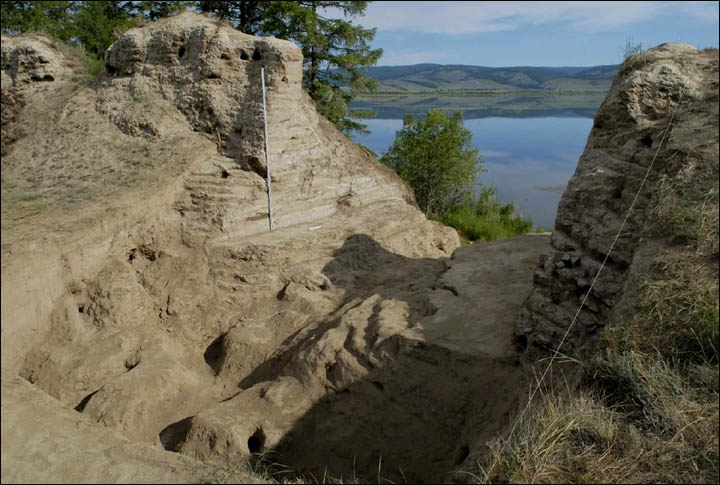
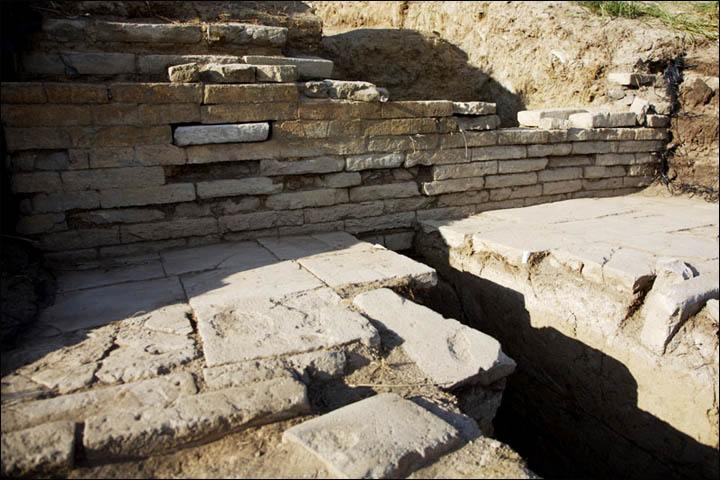
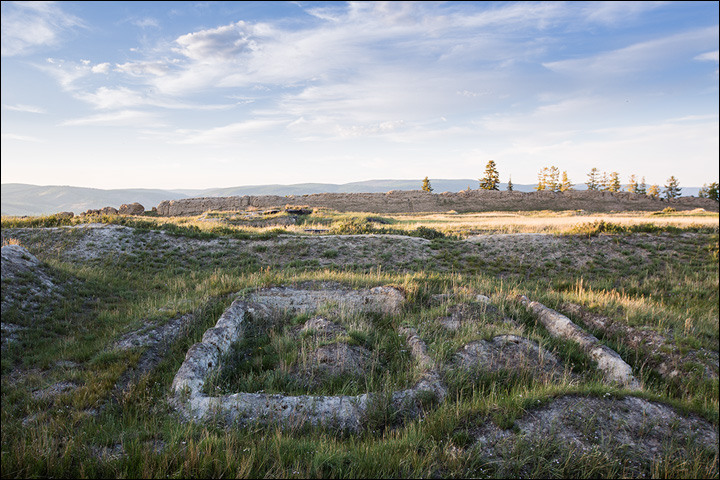
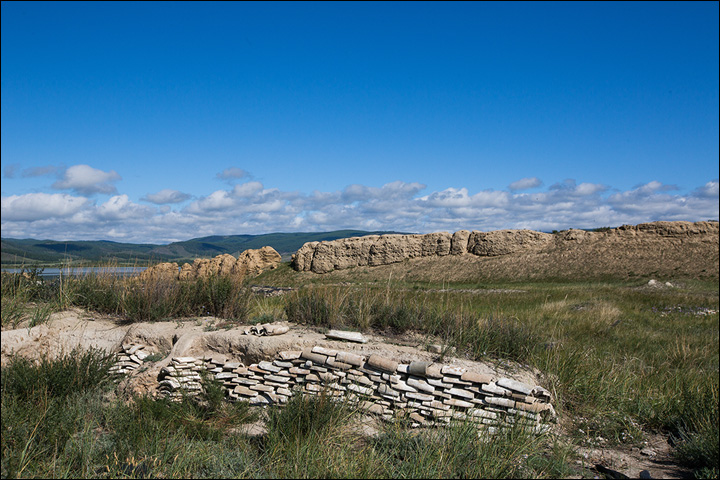
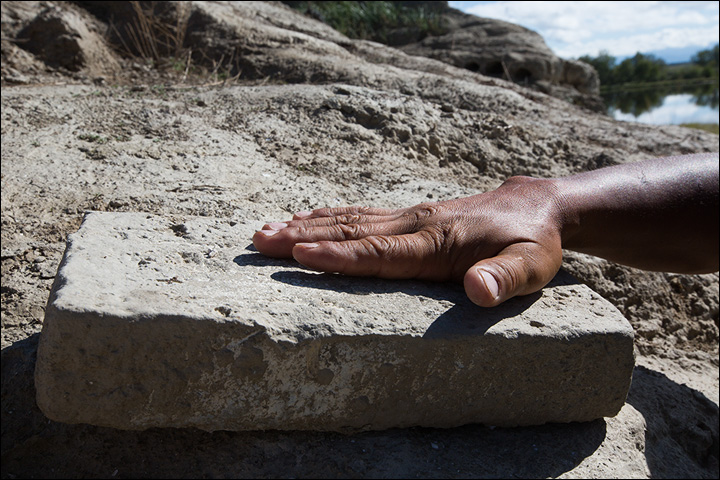
Seven years later: the pictures show the archaeological excavation on Por Bajin held in 2007 - 2008 and the current state of the site. Pictures: 'Por-Bajin Fortress' foundation, Vera Salnitskaya
'Drilling of lake's sediment and the determination of their radiocarbon age showed that it appeared long before the construction of the fortress, not less than 11,000 years ago,' said Dr Arzhantseva. A bridge to the fortress was also unlikely: access had been by boat. The materials used to build the lake were taken from the island itself, or the lake bottom, analysis shows.
Yet while no-one ever lived here, not only was this palace fully completed - in other words it was not semi-built and then deserted - but repairs were carried out on it in the years after its erection.
Demir Tulush, research fellow of the Department of Archaeology of the Tuva Institute of Humanities and Social and Economic Research, said: 'Por-Bajin was completed in full. All the buildings were totally built. More than this, the fortress was repeatedly repaired. Lake Tere-Khol is located in a seismically active zone. Regular small and big earthquakes occur there. On the fortress are visible large faults obviously left by the aftershocks.
'And repaired cracks were revealed in the course of the excavation. For at least ten years it was maintained in good condition. But no one lived there.' During the research, scientists using radiocarbon and dendrochronological methods confirmed the palace was built in the decade starting in 770 AD, and this in turn discounted the theory it had been constructed for Kha Khan Boyan-Chor, who, by then, was already dead.
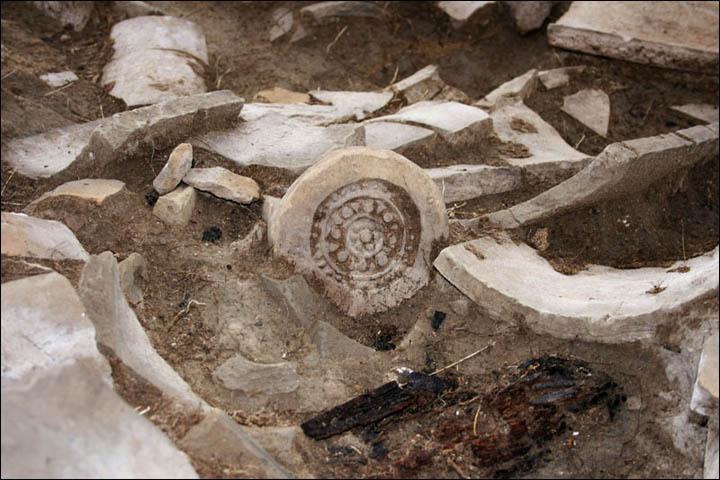
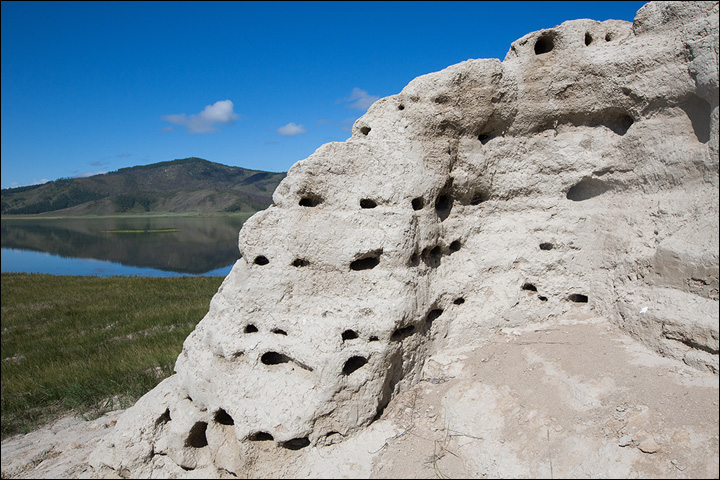
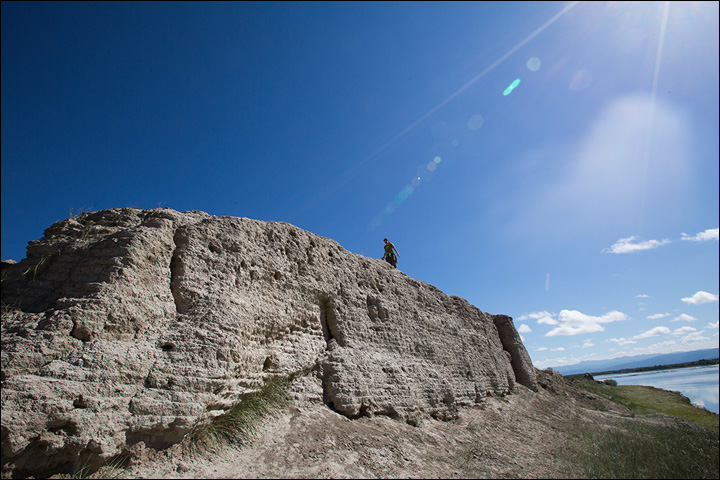
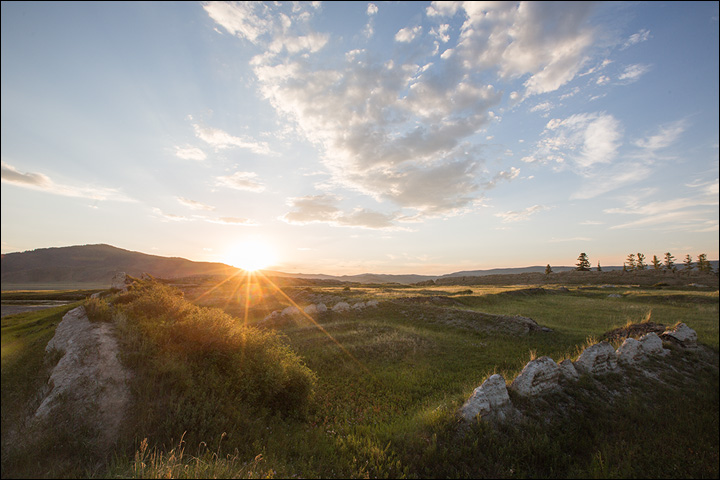
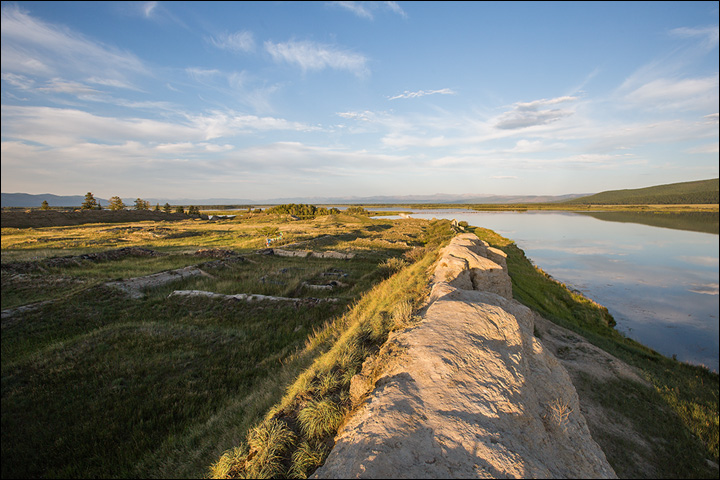
Archaeologists found clay tablets of human feet, faded coloured drawings on the plaster of the walls, giant gates and fragments of burnt wood. Pictures: 'Por-Bajin Fortress' foundation, Vera Salnitskaya
The research also disputed that this was primarily a fortress. Tulush said: 'It was built at a considerable distance from the main commercial and military routes, so there was no sense in the construction of the fortress at this place. Another specific point is its location on an island in the lake. In addition, despite the high walls, it was not attacked, and there were no traces of intentional destruction.'
He concluded: 'It looks like someone built these rather big and complicated facilities - and then abandoned them, not living here at all. It was built gradually, not at once. It was built over several years. Cracks appeared in the walls during the construction, but they were repaired. The main question is - who built this and why it was abandoned? We have several versions.
'The first is that it was a summer palace, and at least its structure is very similar to the known Uighur palaces. But it is located in the remote taiga, so military and administrative management would be difficult from here. It could have been the summer palace built for a Kha Khan's wife', possibly the spouse or intended partner of Byogyu-kagan, son of Boyan-Chor.
'It is known that Chinese princesses could become the wives of Uighur and Turk Kha Khans. Probably, one such princess was destined to live in this palace, but something happened to her on the way here, and she never came to the site, and it was totally abandoned in 30 or 40 years.'
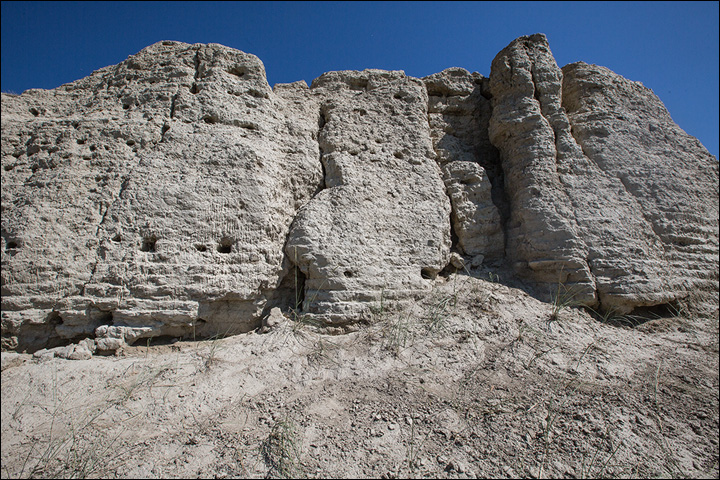
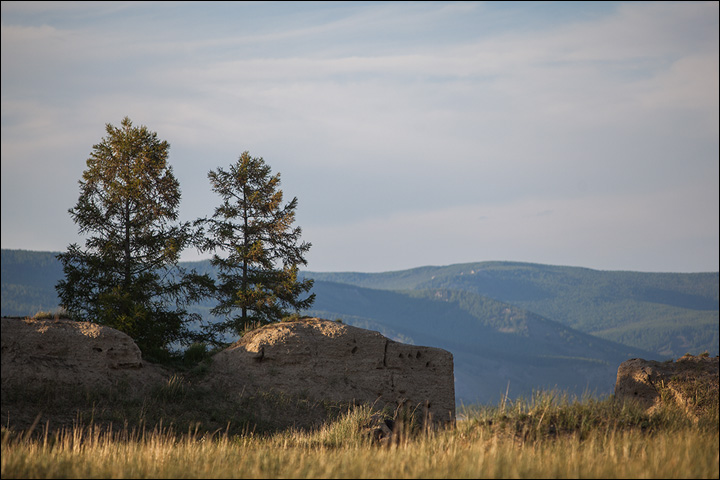
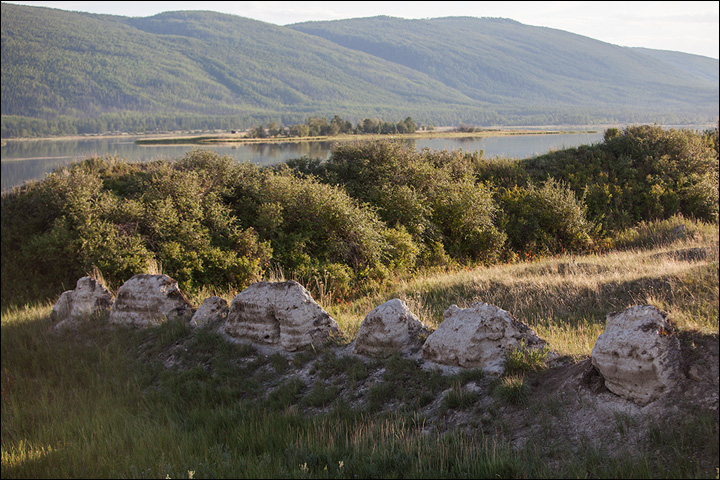
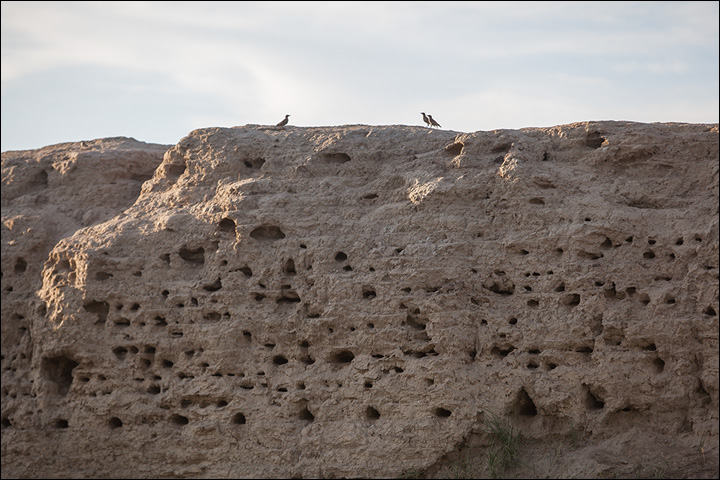
Rapid erosion of its breathtaking but vanishing grandeur may, before too long, deprive archeologists of the opportunity to prove why this place, known as Por-Bajin, was built, and who by. Pictures: Vera Salnitskaya
For now, this seems to be the best guess to explain this remarkable palace, and to answer the question who it was built for. A tragic Chinese who died en route to take up residence. But he has another theory, too.
'The other option is that it could be a temple complex, but not Buddhist, rather Manichaean. It is known that most of the Uighurs practiced Buddhism, but the ruling elite took Manichaeism, and in 760s AD, Manichaeism became the official religion of the Uighur Khanate.'
Byogyu-kagan took Manichaeism, but not all the Uighurs supported him. Possibly, this version goes, he wanted to construct a fortified palace-temple to hide there with his coreligionists. The new data of the construction of Por-Bajin coincides with this theory.
Dr Arzhantseva noted: 'In 779 Byogyu-khagan was killed during an anti-Manichaean coup. If Por-Bajin was finished about 778 - 779 AD, just before the coup, the Kha Khan had no time to use it.'
Yet another theory on Por-Bajin has come from Chinese archeologists, who have suggested it could be a memorial, created in medieval Chinese tradition. Irina Arzhantseva said: 'The custom of arranging burials in beautiful places (in the mountains, near water, for example) and support them with a memorial complex was described in written sources of the Tang dynasty.
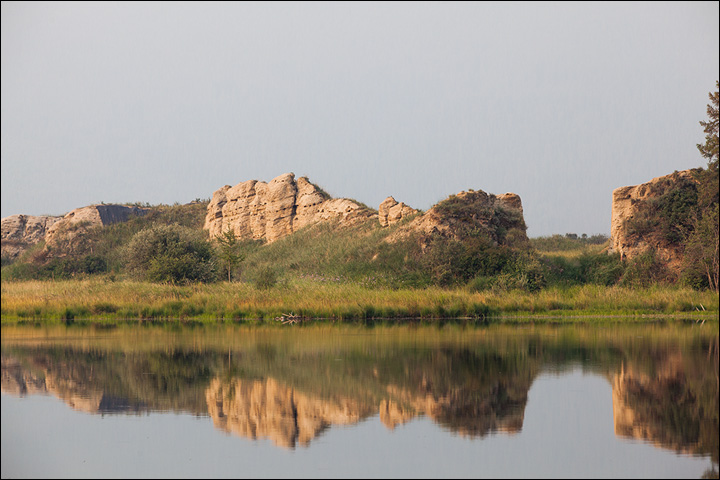
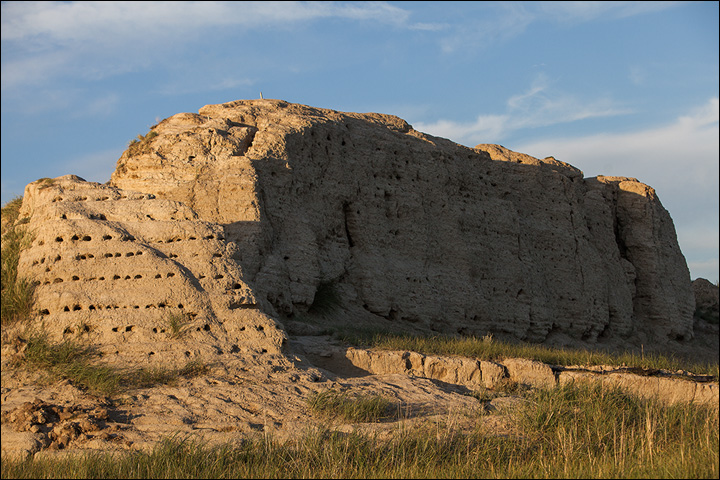
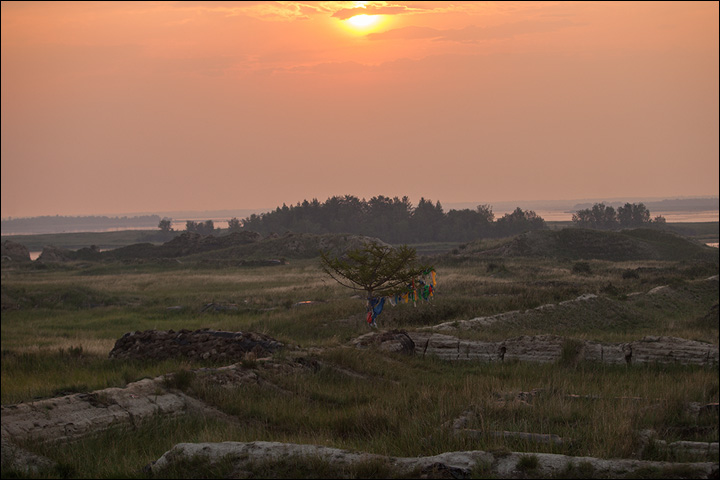
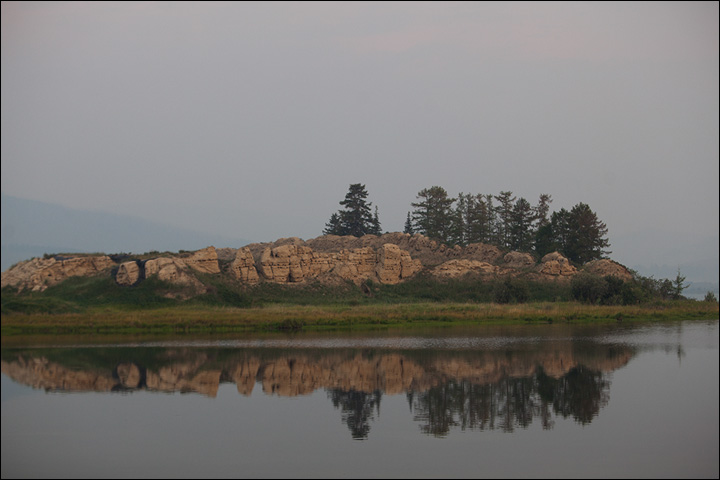
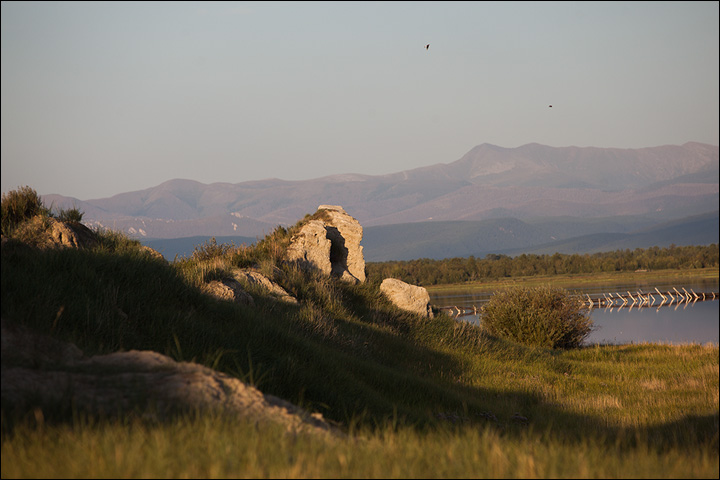
'I have noticed that in seven years after the excavations were finished, on the west side, the shore of the lake has fallen 8-to-10 metres.' Pictures: Vera Salnitskaya
'The royal tomb itself could be located on top of a neighbouring mountain from where the memorial facilities were clearly viewed. In the case of Por-Bajin, the convenient place for burial could be the top or part way up the mountain on the southwest shore of the lake.' As yet, though, no sign of a royal tomb has been found.
The worrying erosion of the ruins at Por-Bajin is due to climate warming which is melting the permafrost. 'Water from the ground leaks into the soil and the permafrost gradually thaws,' said Tulush. 'In winter, the water freezes and expands. In summer thaws again, forms cavities and the ground collapses.
'I have noticed that in seven years after the excavations were finished, on the west side, the shore of the lake has fallen 8-to-10 metres. We need to take some measures to prevent further destruction, but it requires huge funds.'
Among visitors to the site was President Vladimir Putin who summed up what many feel about this magical palace. 'I have been to many places, I have seen many things, but I have never seen anything of the kind,' he said.
My impressions from traveling to Por Bajin
Beware the spirits of the abandoned palace...'where exotic strippers once danced'
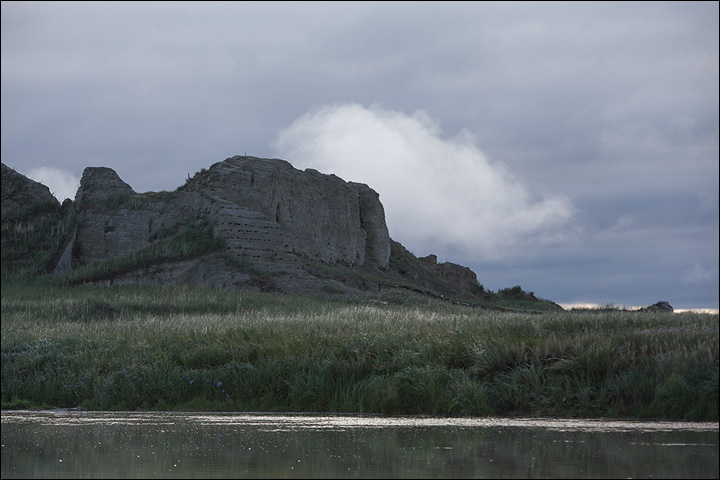

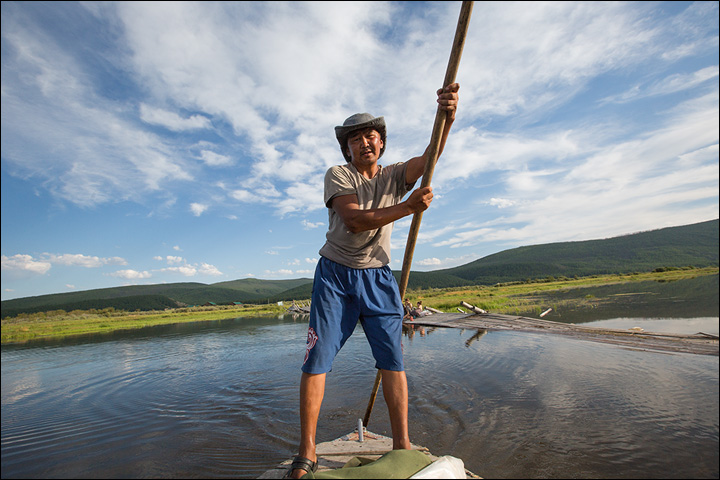
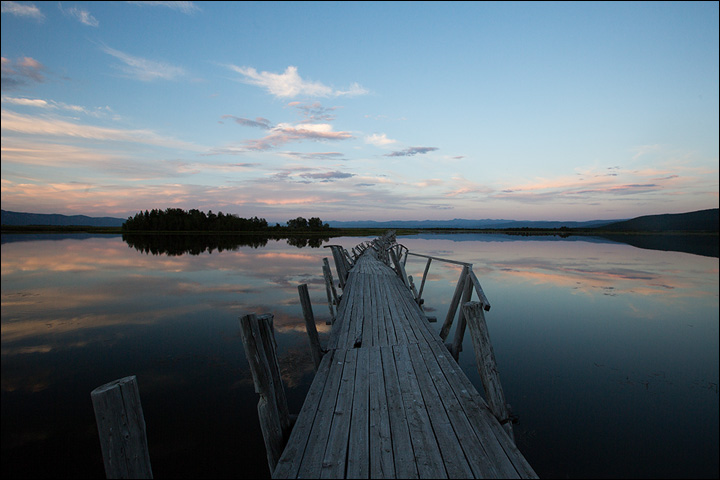
After a tortuous 20 hours in an off-road vehicle you meet the local guide Dorzha Nikitin, who is ready to act as your tour guide. Pictures: Vera Salnitskaya
It can take a tortuous 20 hours to reach Po-Bajin from Tuva capital Kyzyl in good weather in an off road vehicle, and several days if conditions are bad. For wealthy tourists, another option is to fly in by helicopter.
Either way, local resident Dorzha Nikitin, 35, who lives on another island in Lake Tere-Khol will be waiting to act as your tour guide, helped by his aide Romeo, dog Strelka and cat Kysa. Between helping visitors, he fishes for pike, which he then smokes to sell to tourists.
Dorzha has his own take on the ancient palace, as he obligingly explains. 'This was a Khan's palace, and here in front of it, danced strippers for his amusement. Behind the palace you see the magnificent taiga, very beautiful.'
He shows bricks with prints of hands and burned wood. Somewhere in the Khan's Palace is hidden a treasure trove, but the spirits forbid it to be dug, he says. 'You cannot take anything from the island, the spirits are strictly against it, he explains.
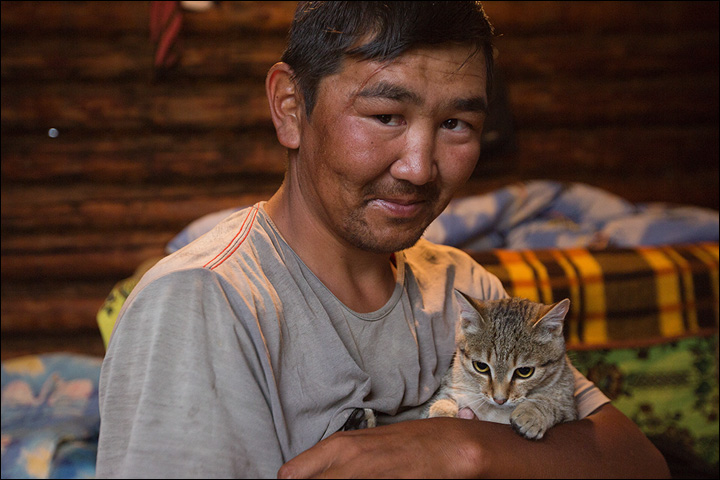
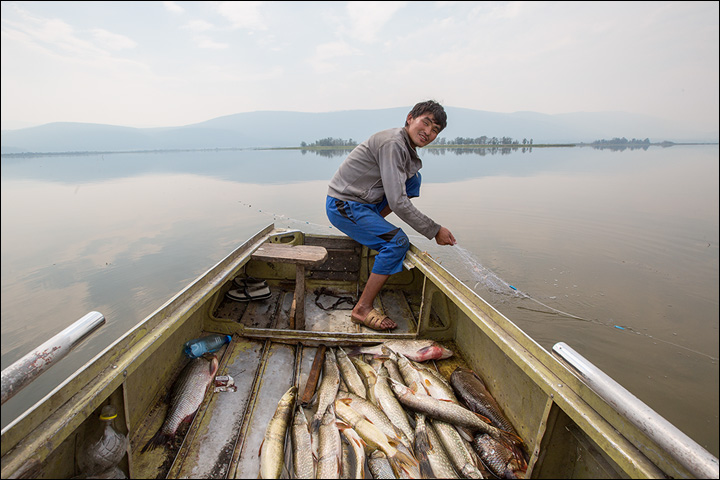
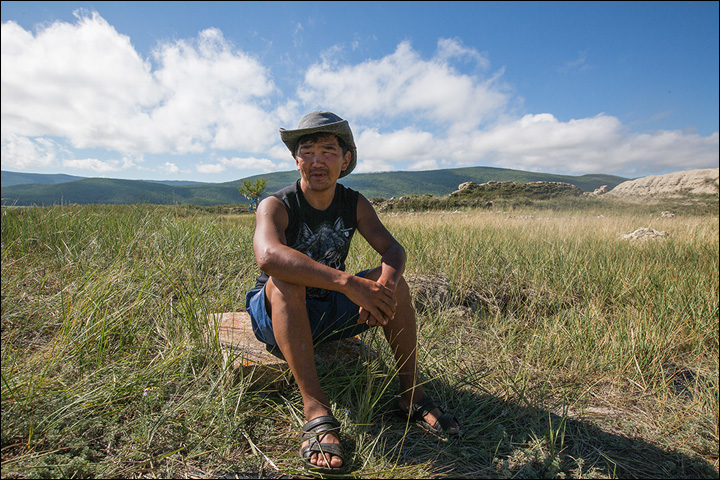
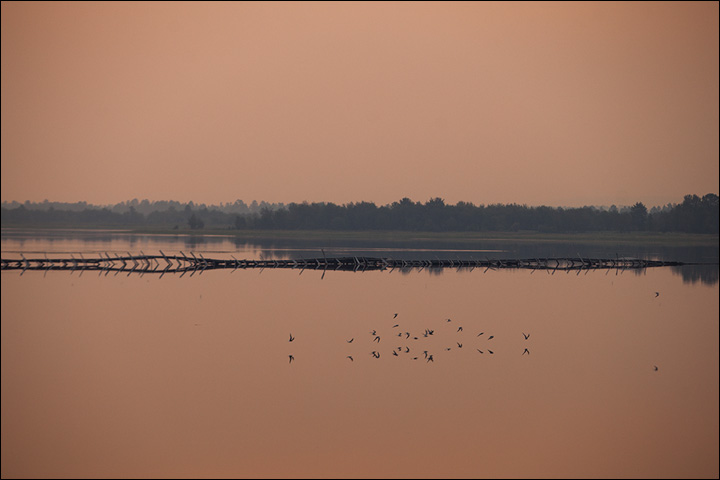

Dorzha Nikitin lives on another island in Lake Tere-Khol with his aide Romeo, dog Strelka and cat Kysa. Between helping visitors, he fishes for pike. Pictures: Vera Salnitskaya
'Even if you take a stone, then your car will break down on the road. One tourist took a piece of tile and promptly missed his plane. Then a Japanese woman picked up a tile from the floor, and for three days she could not get to Kyzyl. Other bad things happen to them, too, and they get sick and die. We have to call the shamans to ward off the spirits.
'Take the example of Romeo's family. They took the bricks from the island, to build a traditional stove, and then promptly died. Before the excavation, we needed to call the shamans. They made a long rite, lasting almost the whole day long. One told how he saw a vision as if the man lay on top of the fortress, and did not allow it to be dug up. But then he left. And the other saw a throne, on the exact spot where a tree grows.'
Subscribe to:
Posts (Atom)








